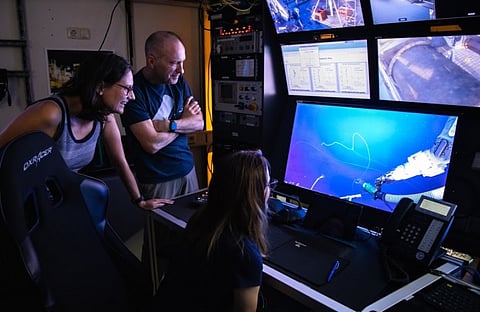

An estimated 45-metre-long siphonophore–-seemingly the longest animal ever recorded–-was discovered during a month-long scientific expedition exploring the submarine canyons near Ningaloo off Western Australia.
Additionally, up to 30 new underwater species were found by researchers from the Western Australian Museum aboard Schmidt Ocean Institute's research vessel Falkor.
The discovery of the massive gelatinous string siphonophore–-a floating colony of tiny individual zooids that clone themselves thousands of times into specialised bodies that string together to work as a team–-was just one of the unique finds among some of the deepest fish and marine invertebrates ever recorded for Western Australia.
Scientists from the Western Australian Museum, led by Chief Scientist Dr Nerida Wilson, were joined by researchers from Curtin University, Geoscience Australia, and Scripps Institution of Oceanography in exploring the Ningaloo Canyons in the Indian Ocean. Using an underwater robot, the remotely operated vehicle (ROV) SuBastian, they completed 20 dives at depths of up to 4,500 metres over 181 hours of exploration.
During the expedition, scientists collected the first giant hydroids in Australia, discovered large communities of glass sponges in Cape Range Canyon, and observed for the first time in Western Australia the bioluminescent Taning's octopus squid, long-tailed sea cucumber, and a number of other molluscs, barnacle and squat lobster species.
Some of the species collected will be exhibited at the Western Australian Museum.
The team also found the largest specimen of the giant Apolemia siphonophore ever recorded.
The expedition is part of Schmidt Ocean Institute's year-long initiative in Australia and the Pacific to conduct a number of science and engineering expeditions with teams of scientists and researchers from around the world. Using the underwater robot SuBastian, scientists for the first time are able to explore deep sea canyons and coral reefs around Australia that have never been seen before.
The footage and samples collected from the oceans that surround Australia will have important implications for the sustainability and protection of these underwater ecosystems, and for similar habitats worldwide that are in peril because of rising ocean temperatures and other environmental threats.
The science completed will allow the research team to formally describe many of the new species of animals that were found, develop ROV methodology for monitoring Marine Parks in Australia, and screen deep water samples for environmental DNA in the Indian Ocean.
The footage and specimens collected are important records within the Gascoyne Marine Park, serving as a permanent record of biodiversity in the canyons to build on in the future.
